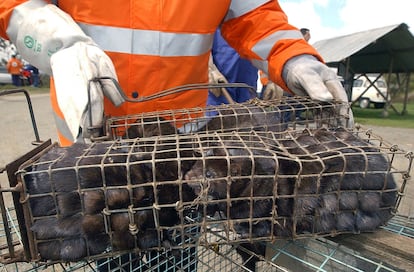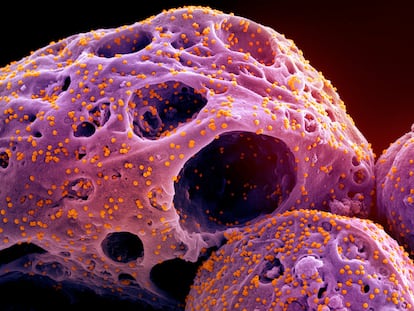Avian flu outbreak at Spanish mink farm sets off global alarm bells
Research on a case that occurred three months ago suggests that the virus jumped from wild birds and mutated at the facility, where all the animals were culled

It’s like a script for a disaster movie that everyone has already seen. Europe is going through the most devastating bird flu epidemic in its history, with more than 50 million poultry slaughtered in one year. At the beginning of autumn, seagulls and gannets killed by this virus appeared on the beaches of Spain’s northwestern Galicia region. Days later, in early October, American mink began to die of hemorrhagic pneumonia on a fur farm in Carral, a few minutes’ drive from the city of A Coruña. Mortality in this outbreak exceeded 4% in a single week.
A scientific study now suggests that the avian flu virus jumped from wild birds to mink and mutated on the farm, beginning to spread from mammal to mammal but failing to infect mask-wearing farm workers. This outbreak has set off alarm bells across the planet. The Dutch virologist Marion Koopmans, who traced the origin of the Covid pandemic for the World Health Organization (WHO), has issued a warning on her social media accounts: “We are playing with fire.”
The British doctor Jeremy Farrar, an expert in emerging diseases who was recently appointed chief scientist at the WHO, has also alerted about the recent outbreak in Spain on his social media. “The greatest risk of a devastating flu pandemic is avian or animal flu that infects intermediate mammals, and evolves to mammal-to-mammal and human-to-human transmission with little or no human immunity,” he said on Twitter. Farrar, who correctly alerted the world to a strange pneumonia in the Chinese city of Wuhan on December 31, 2019, is now urging authorities to prepare vaccines and treatments for each type of animal flu.
A mixing vessel
Mink are susceptible to both bird flu and human flu, so these animals can act as a mixing vessel in which viruses mix and more lethal versions emerge, warns the study, which was led by Montserrat Agüero of the Central Veterinary Laboratory of Spain’s Ministry of Agriculture and her Italian colleague Isabella Monne, from the Istituto Zooprofilattico Sperimentale delle Venezie (IZSVe).
The culprit in the Galician outbreak is a highly pathogenic avian influenza A (H5N1) virus, with an unusual mutation called T271A, a disturbing characteristic that was already present in the swine flu virus that caused a pandemic in humans in 2009. Regional health authorities decided on October 18 to immediately cull the 52,000 mink on the farm, located outdoors and with easy access to wild animals.
Virologists’ worst nightmare would be the leap to humans of a deadly flu virus. The WHO had already warned in 2019, before Covid, that “the world is not prepared for a pandemic of virulent and rapidly transmitted respiratory pathogens.” The institution then said that a pandemic such as the 1918 flu could kill 80 million people, “causing panic, destabilizing national security and seriously affecting economy and trade.”
It’s pretty scary. In Europe there had never been such an outbreak in mink beforeElisa Pérez, virologist
The virologist Elisa Pérez, an expert in emerging viruses at Spain’s Animal Health Research Center (INIA-CISA), is very concerned. “It’s pretty scary. In Europe there had never been such an outbreak in mink before, there were only a few cases described in China. We had never had such a big scare,” she warns. Pérez would like for all mink farms to be shut down as soon as possible. “What else needs to happen?”
Before the Covid pandemic, there were around 2,900 fur farms in the European Union, producing 27 million mink pelts each year, according to official industry figures. After the coronavirus outbreaks in hundreds of farms in 2020, some countries, such as Denmark and the Netherlands, ordered massive culls and closures. A report by European authorities estimated that there were 755 mink farms left in operation at the start of 2021, mainly in Finland, Poland, Lithuania and Greece. In Spain, that crisis caused some security measures to be implemented, such as mandatory face masks for workers.
Bird flu is spreading around the world. The virus has already settled in South America, a team of scientists from Argentina and Peru warned last week. On the Peruvian coasts, 22,000 wild birds died in just one month, especially pelicans and boobies. On January 9, a nine-year-old girl from a village in Bolívar (Ecuador), admitted to intensive care after being in contact with chickens, became the first human case of highly pathogenic avian influenza in Latin America. The WHO warned last Wednesday that the diversity of flu viruses that are jumping from animals to people is “alarming.”
In Spain last year there were 37 outbreaks of highly pathogenic avian influenza in poultry, the last two in a farm with 150,000 laying hens in Guadalajara and in another with 1,500 geese in La Cistérniga (Valladolid), according to figures provided by the Ministry of Agriculture. Two workers at the Guadalajara farm became infected with the virus without developing symptoms. In the Carral outbreak, the 11 employees who were in contact with the mink remained in isolation for 10 days, despite having tested negative for avian flu.
The virus is easily transmitted between birds, but only rarely does it pass from bird to human. Between people it has not yet managed to jump effectively, although the outbreak in mink in A Coruña suggests that the virus is capable of mutating and adapting rapidly to jumping from mammal to mammal.
The epidemiologist Matthew Baylis, former director of The Pandemic Institute in Liverpool, has also reacted to the analysis of the Galician outbreak. “Two years ago I wrote about the risks of mink farming for Covid. And now we see even greater risks for avian influenza, as mink provide a wonderful opportunity for the virus to adapt to mammals. This is where the next pandemic may come from,” he tweeted. “Is anyone heeding the warning sign? Clearly not.”
Sign up for our weekly newsletter to get more English-language news coverage from EL PAÍS USA Edition
Tu suscripción se está usando en otro dispositivo
¿Quieres añadir otro usuario a tu suscripción?
Si continúas leyendo en este dispositivo, no se podrá leer en el otro.
FlechaTu suscripción se está usando en otro dispositivo y solo puedes acceder a EL PAÍS desde un dispositivo a la vez.
Si quieres compartir tu cuenta, cambia tu suscripción a la modalidad Premium, así podrás añadir otro usuario. Cada uno accederá con su propia cuenta de email, lo que os permitirá personalizar vuestra experiencia en EL PAÍS.
¿Tienes una suscripción de empresa? Accede aquí para contratar más cuentas.
En el caso de no saber quién está usando tu cuenta, te recomendamos cambiar tu contraseña aquí.
Si decides continuar compartiendo tu cuenta, este mensaje se mostrará en tu dispositivo y en el de la otra persona que está usando tu cuenta de forma indefinida, afectando a tu experiencia de lectura. Puedes consultar aquí los términos y condiciones de la suscripción digital.
More information
Archived In
Últimas noticias
Tiger Woods turns 50: Will he continue playing on the PGA Tour or take a back seat?
The surreal journey of James Nnaji, the Barcelona youth player selected in the NBA Draft who ended up in the NCAA
Trump claims peace in Ukraine is near, but Moscow suggests otherwise
A survivor’s account of the Interoceanic Train accident: ‘We were scared because of the speed on the curve’
Most viewed
- Oona Chaplin: ‘I told James Cameron that I was living in a treehouse and starting a permaculture project with a friend’
- Reinhard Genzel, Nobel laureate in physics: ‘One-minute videos will never give you the truth’
- Why the price of coffee has skyrocketed: from Brazilian plantations to specialty coffee houses
- Pablo Escobar’s hippos: A serious environmental problem, 40 years on
- Chevy Chase, the beloved comedian who was a monster off camera: ‘Not everyone hated him, just the people who’ve worked with him’











































